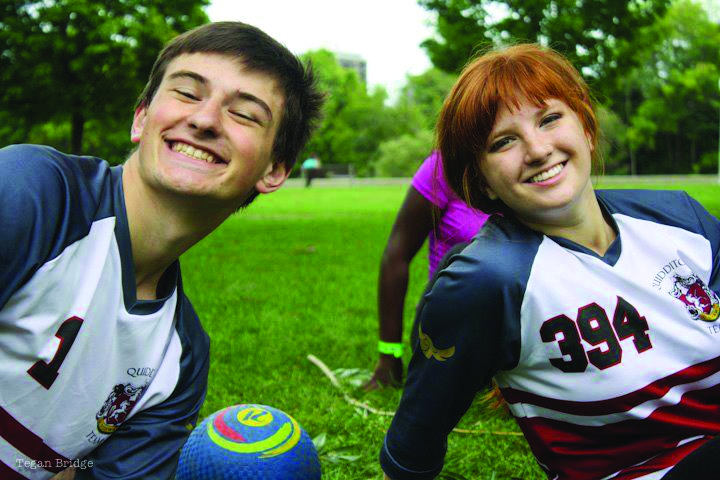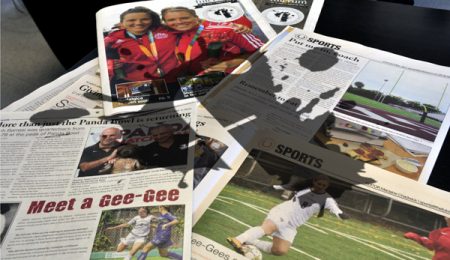Title 9 ¾ promotes gender-integrated approach to interuniversity athletics
Photo by Tegan Bridge
RUNNING AROUND WITH a broom between your legs while trying to catch a tiny golden ball with wings is different to say the least, but it’s not the only thing that sets quidditch apart from the rest of the sporting world.
Instead of modelling itself on traditional sport, usually segregated by gender, quidditch has adopted a gender-integrated approach to interuniversity sport. And by doing so, it has upped the ante on inclusivity.
Title 9 ¾ is an advocacy and awareness branch of the International Quidditch Association (IQA) seeking to promote gender quality and inclusivity within the sport.
The name plays off of Title IX—a U.S. law seeking to prevent gender discrimination within the American education system, including sports.
It’s also a Harry Potter joke, referring to the fictional platform that acts as an access point to the Hogwarts Express.
Implemented in the 1970s, Title IX is meant to promote equal opportunity. It states that no person should be excluded from participation in any activity or educational program on the basis of sex, nor should they be denied any benefits or be subject to discrimination.
Many countries, including Canada, follow similar guidelines.
This is why the University of Ottawa offers more women’s varsity programs than men’s—they must allocate the same number of varsity spots to both men and women. For example, since not a single women’s sport corresponds with the size of the men’s football roster, the university promotes varsity teams in women’s soccer, rugby and volleyball to maintain a balance of genders.
Colin Timm, assistant director of the programs and services for Sports Services explained that, in terms of resources and funding at the program and individual player level, “there is no separation between our men’s and our women’s sports.”
“It is equitable across both genders,” he said. “We don’t differentiate between one or the other.”
But while most universities and sports organizations define gender equality in terms of participation, budgeting and varsity allotment, quidditch views gender equality a little differently.
According to the IQA website, Title 9 ¾ seeks to take the good nature of Title IX a step further by “promoting a sport that is free of gender-based restrictions, rather than segregated between men and women.”
“Being a gender-integrated sport is really important to us,” said Sarah Woosley, development director for the IQA. “And I think what sets us apart from other sports is that we do have core values that [focus on] how we cannot only improve our sport and improve our league, but how we can improve our community.”
By creating a level playing field for all genders, the IQA hopes to help eliminate gender bias and positively influence how players view other genders.
A survey completed by the IQA shows that the community was positively influenced by the quidditch views of gender and gender issues. Some respondents also noted that quidditch increased their awareness of gender bias in sport and helped increase their respect for female athletes.
“It’s actually very different from other sport leagues,” said Woosley. “As far as I’m aware, I haven’t found any other sports that [does things] the same way that we do.”
In fact, most sports operate under a gender-segregated structure.
“It’s to go in line with the national federations and the international federations,” explained Pierre Lafontaine, CEO of Canadian Interuniversity Sport.
Timm said the sports offered at the varsity and competitive club levels are based on the specific structures in place so that their student-athletes can move on professionally in the sporting world.
“It’s looking at what the definition of what a sport is and what an activity is,” he said. “And within the sports structure that we work in it’s fairly clearly defined that that separation exists between men and women.”
But even though gender segregation is a standard of competitive sport, Clare Hutchinson, a coordinator for Title 9 ¾, doesn’t believe it is necessary to follow this model—especially since it promotes a gender binary.
Part of what makes quidditch even more unique is that within its gender rules, it acknowledges that the gender binary does not cover all quidditch players—or all of society for that matter.
The quidditch gender rule, also called the two-minimum rule, uses inclusive and non-discriminatory language to ensure that all different gender identities and gender expressions feel welcome and safe within the quidditch community.
“It’s not four men and two women; it’s four males and two non-males for example,” explained Woosley. Whereas other sports do promote inclusivity on the basis of race, religion, colour and sexual orientation, their regulations on gender limit participation of individuals who are in transition or who don’t identify at either end of the gender spectrum.
“Sexual orientation, gender identity and gender expression are issues that haven’t really been discussed in the sports world very much and something that’s been kind of a taboo topic,” said Woosley.
Most sports follow the international standards set by the International Olympic Committee (IOC). In 2003, the IOC recommended that individuals who have undergone sex reassignment surgery should be able to compete two years after undergoing the appropriate surgical, hormonal, and legal processes.
These are many obstacles to overcome just to play sports and not all trans individuals necessarily want or feel the need to change their physical characteristics.





